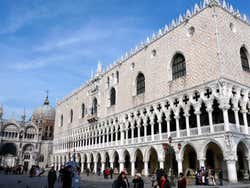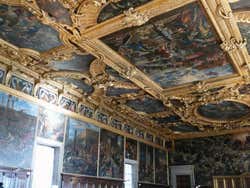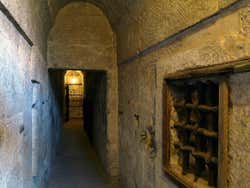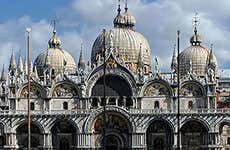
Palazzo Ducale
The Doge's Palace is one of the symbols of Venice. The palace has been used for everything from the residence of the Doge to the prison of the Venetian Republic.
The Doge’s Palace, in Italian Palazzo Ducale, is located in Piazza San Marco. The Doge's Palace was originally a fortified castle founded between the 10th and 11th centuries. The palace was partially destroyed by a fire and was rebuilt between 1172 and 1178, as was the Piazza San Marco. During this period, the Palazzo was used as a fortress and prison.
The structure combines layers of different architectural styles, including Byzantine, Gothic, and Renaissance. This impressive building houses paintings by renowned Italian artists such as Titian, Tintoretto, and Bellini.
The building has been the Doges' residence and public offices since the old castle was built in 810. Over nearly 1,000 years, 120 doges ruled over Venice from the Doge’s Palace.
Visiting the Doge's Palace
Visitors will be welcomed by an impressive golden staircase that leads to the second floor called Scala d’Oro. In the palazzo, you will visit the Doge’s Apartments, the courtyard, the Institutional Chambers, the armoury, and the prisons.
The Doge’s Apartments are beautifully decorated with works of art by Veronese, Titian and Tintoretto that depict the city’s history.
Subsequently, you will visit the Maggior Consiglio hall, where over 1,000 people would go to vote to decide the future of the Serenissima. This hall contains the world’s largest painting, called “Paradise” by Tintoretto.
The armoury contains a vast collection of armaments and weapons from different periods.
The visit finishes in the Dungeons, where you will see the prisoners’ cells and humid wells (pozzi) and get a real sense of how awful the confinements were in those days.
Giacamo Casanova, the famous lover of Venice, was the only man to escape the Doge’s Palace prison by climbing onto the roof of the palace in 1756.
Bridge of Sighs
You will get to cross the renowned Bridge of Sighs during your visit, the Baroque-style overpass built during the 17th century to give access to the prisons of the Palazzo. The melancholic name comes from when the men condemned to death would cross the Bridge and see the Lagoon for the last time.
The Bocca di Leone is a curious type of letterbox in the shape of a lion’s head, where citizens would write notes and report against other Venetians who had done something illegal.
Guided Tours
If you would like to skip the lines and discover the best of the palace, take a look at our guided tour:
With this option, you can visit St. Mark's Basilica and the Doge's Palace with tickets included:
You can also make the most of your time in Venice to visit the Doge's Palace and St. Mark's Basilica in a very complete 4-hour tour, which also includes entrance to the four museums in St. Mark's Square:



Schedule
Daily from 9:00 am until 6:00 pm (April to October until 7 pm)
Price
Adults: € 30 (US$ 34.55) (online 30 days in advance: € 25 (US$ 28.79)).
Children from 6 to 14 years old, students from 15 to 25 years old, and seniors over 65 years old: € 15 (US$ 17.27) (online 30 days in advance: € 13 (US$ 14.97)).
Children under 5 years old: free entry.
Rolling Venice Card: € 15 (US$ 17.27).
Museum Pass: € 40 (US$ 46.07), reduced € 22 (US$ 25.34). Includes the museums in St. Mark's Square: the Doge's Palace, Museo Correr, Museo Archeologico Nazionale, and the Biblioteca Nazionale Marciana.
Doge's Palace Guided Tour € 56 (US$ 64.50)
Transport
Water Bus: San Zaccaria or San Marco, lines 1, 2, 41, 42, 51, 52, N and LN
Nearby places
Campanile di San Marco (73 m) San Marco (74 m) Basilica di San Marco (81 m) Piazza San Marco (143 m) Museo Correr in Venice (209 m)

